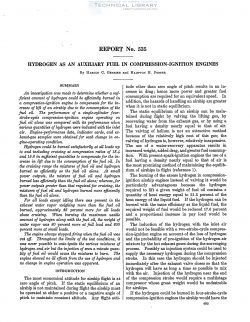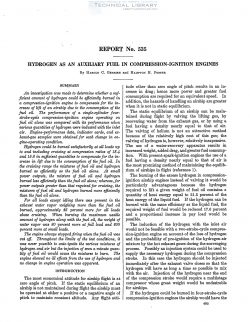naca-report-535

- Version
- 141 Downloads
- 1.41 MB File Size
- 1 File Count
- August 30, 2016 Create Date
- August 30, 2016 Last Updated
National Advisory Committee for Aeronautics, Report - Hydrogen as an Auxiliary Fuel in Compression Ignition Engines

An investigation was made to determine whether a suf-
ficient amount of hydrogen could be efliciently burned in
a compression-ignition engine to compensate for the 1:71:-
crease of lift of an airship due to the consumption of the
fuel oil. The performance of a single-cylinder four-
strolce-cycle compression—ignition engine operating on
fuel oil alone was compared with its performance when .
various quantities of hydrogen were inducted with the inlet
air. Engine-performance data, indicator cards, and ea:-
haust—gas samples were obtained for each change in en-
gine-operating condition.
Hydrogen could be burned satisfactorily at all loads up
to and including cruising at compression ratios of 13.4
and 1 6 .6 in suflicient quantities to compensate for the im
crease in lift due to the consumption of the fuel oil. In
the cruising range the mixtures of fuel oil and hydrogen
burnedasefiicientlyasthefueloilalone. Atsmall
power outputs, the mixture of fuel oil and hydrogen
burned less efficiently than the fuel oil alone; whereas, for
power outputs greater than that required for musing, the
mixtures of fuel oil and hydrogen burned more efiiciently
than the fuel oil alone.
For all loads except idling there was present in the
exhaust water vapor weighing more than the fuel oil
burned, approximately .95 percent more for all loads
above cruising. When burning the maximum usable
amount of hydrogen along with the fuel oil, the weight of
water vapor was 80 percent more at full load and 200
percent more at small loads.
The engine always stopped firing when the fuel oil was
cut of. Throughout the limits of the test conditions, it
was never possible to auto-ignite the various mixtures of
hydrogen and air but the injection of even a minute gnaw
tity of fuel oil would cause the miatures to burn. The
engine showed no ill ejects from the use of hydrogen and
no change in engine operation was apparent.
| File | Action |
|---|---|
| naca-report-535 Hydrogen as an Auxiliary Fuel in Compression Ignition Engines.pdf | Download |
Comment On This Post